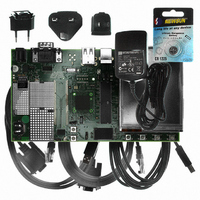AT91SAM9G10-EK Atmel, AT91SAM9G10-EK Datasheet - Page 245

AT91SAM9G10-EK
Manufacturer Part Number
AT91SAM9G10-EK
Description
KIT DEV FOR SAM9G10 ARM
Manufacturer
Atmel
Type
MCUr
Specifications of AT91SAM9G10-EK
Contents
Board, Cables, Power Supply
Silicon Manufacturer
Atmel
Core Architecture
AVR
Kit Contents
Board
Svhc
No SVHC (15-Dec-2010)
Mcu Supported Families
AT91SAM9G10, ARM926EJ-S
Tool / Board Applications
Microcontroller
Rohs Compliant
Yes
For Use With/related Products
*
Lead Free Status / RoHS Status
Contains lead / RoHS non-compliant
- Current page: 245 of 730
- Download datasheet (12Mb)
6462A–ATARM–03-Jun-09
2. Checking the Main Oscillator Frequency (Optional):
3. Setting PLL A and divider A:
4. Setting PLL B and divider B:
In some situations the user may need an accurate measure of the main oscillator frequency.
This measure can be accomplished via the CKGR_MCFR register.
Once the MAINRDY field is set in CKGR_MCFR register, the user may read the MAINF field
in CKGR_MCFR register. This provides the number of main clock cycles within sixteen slow
clock cycles.
All parameters necessary to configure PLL A and divider A are located in the CKGR_PLLAR
register. ICPPLLA in PMC_PLLICPR register must be set to 1 before configuring the
CKGR_PLLAR register.
It is important to note that Bit 29 must always be set to 1 when programming the
CKGR_PLLAR register.
The DIVA field is used to control the divider A itself. The user can program a value between
0 and 255. Divider A output is divider A input divided by DIVA. By default, DIVA parameter is
set to 0 which means that divider A is turned off.
The OUTA field is used to select the PLL A output frequency range.
The MULA field is the PLL A multiplier factor. This parameter can be programmed between
0 and 2047. If MULA is set to 0, PLL A will be turned off. Otherwise PLL A output frequency
is PLL A input frequency multiplied by (MULA + 1).
The PLLACOUNT field specifies the number of slow clock cycles before LOCKA bit is set in
the PMC_SR register after CKGR_PLLAR register has been written.
Once CKGR_PLLAR register has been written, the user is obliged to wait for the LOCKA bit
to be set in the PMC_SR register. This can be done either by polling the status register or by
waiting the interrupt line to be raised if the associated interrupt to LOCKA has been enabled
in the PMC_IER register.
All parameters in CKGR_PLLAR can be programmed in a single write operation. If at some
stage one of the following parameters, SRCA, MULA, DIVA is modified, LOCKA bit will go
low to indicate that PLL A is not ready yet. When PLL A is locked, LOCKA will be set again.
User has to wait for LOCKA bit to be set before using the PLL A output clock.
Code Example:
PLL A and divider A are enabled. PLL A input clock is main clock divided by 5. PLL An out-
put clock is PLL A input clock multiplied by 4. Once CKGR_PLLAR has been written,
LOCKA bit will be set after six slow clock cycles.
All parameters needed to configure PLL B and divider B are located in the CKGR_PLLBR
register. ICPPLLB in PMC_PLLICPR register must be set to 1 before configuring the
CKGR_PLLBR register.
The DIVB field is used to control divider B itself. A value between 0 and 255 can be pro-
grammed. Divider B output is divider B input divided by DIVB parameter. By default DIVB
parameter is set to 0 which means that divider B is turned off.
The OUTB field is used to select the PLL B output frequency range.
write_register(CKGR_PLLAR,0x20030605)
AT91SAM9G10
245
Related parts for AT91SAM9G10-EK
Image
Part Number
Description
Manufacturer
Datasheet
Request
R

Part Number:
Description:
MCU, MPU & DSP Development Tools KICKSTART KIT FOR AT91SAM9 PLUS
Manufacturer:
IAR Systems

Part Number:
Description:
DEV KIT FOR AVR/AVR32
Manufacturer:
Atmel
Datasheet:

Part Number:
Description:
INTERVAL AND WIPE/WASH WIPER CONTROL IC WITH DELAY
Manufacturer:
ATMEL Corporation
Datasheet:

Part Number:
Description:
Low-Voltage Voice-Switched IC for Hands-Free Operation
Manufacturer:
ATMEL Corporation
Datasheet:

Part Number:
Description:
MONOLITHIC INTEGRATED FEATUREPHONE CIRCUIT
Manufacturer:
ATMEL Corporation
Datasheet:

Part Number:
Description:
AM-FM Receiver IC U4255BM-M
Manufacturer:
ATMEL Corporation
Datasheet:

Part Number:
Description:
Monolithic Integrated Feature Phone Circuit
Manufacturer:
ATMEL Corporation
Datasheet:

Part Number:
Description:
Multistandard Video-IF and Quasi Parallel Sound Processing
Manufacturer:
ATMEL Corporation
Datasheet:

Part Number:
Description:
High-performance EE PLD
Manufacturer:
ATMEL Corporation
Datasheet:

Part Number:
Description:
8-bit Flash Microcontroller
Manufacturer:
ATMEL Corporation
Datasheet:

Part Number:
Description:
2-Wire Serial EEPROM
Manufacturer:
ATMEL Corporation
Datasheet:










